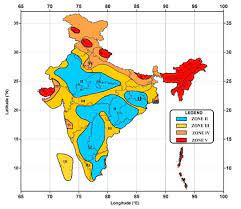India is located in a seismically active zone, and experiences frequent earthquakes. Here are the list of major Earthquake Zones in India:

India has been divided into several seismic zones based on the historical and scientific data of earthquakes in the region. These zones are numbered from 1 to 5, with zone 5 being the most seismically active and zone 1 being the least.
Table of Contents
List of Earthquake Zones in India
- Zone 1: This zone covers areas with very low seismic activity. The areas in this zone include parts of Gujarat, Rajasthan, and the Andaman and Nicobar Islands.
- Zone 2: This zone includes regions with low seismic activity. The areas in this zone include parts of Jammu and Kashmir, Himachal Pradesh, Uttarakhand, and the northeastern states.
- Zone 3: This zone covers areas with moderate seismic activity. The areas in this zone include parts of Gujarat, Uttar Pradesh, Bihar, West Bengal, and the northeastern states.
- Zone 4: This zone includes regions with high seismic activity. The areas in this zone include parts of Jammu and Kashmir, Himachal Pradesh, Punjab, Uttarakhand, Haryana, Delhi, Rajasthan, Gujarat, Maharashtra, and the northeastern states.
- Zone 5: This zone covers areas with very high seismic activity. The areas in this zone include parts of Jammu and Kashmir, Himachal Pradesh, Uttar Pradesh, Bihar, West Bengal, Sikkim, Assam, Arunachal Pradesh, Nagaland, Manipur, Mizoram, Meghalaya, Tripura, and Andaman and Nicobar Islands.
It’s important to note that earthquakes can still occur in areas outside of these seismic zones, and that building codes and safety measures should always be taken seriously to prepare for seismic activity.
Summary: List of Earthquake Zones in India
- Earthquake zones are areas on Earth’s surface where earthquakes are likely to occur due to tectonic activity.
- Major earthquake zones around the world include the Pacific Ring of Fire, the Mediterranean-Alpine region, the Mid-Atlantic Ridge, and the East African Rift.
- India has been divided into five seismic zones based on the historical and scientific data of earthquakes in the region.
- Zone 1 in India has very low seismic activity, while Zone 5 has very high seismic activity.
- Earthquakes can still occur in areas outside of these seismic zones.
- Building codes and safety measures should be taken seriously to prepare for seismic activity.
- Earthquakes in the zones of earthquake are typically caused by tectonic activity, which occurs along the boundaries of Earth’s tectonic plates.
- The Pacific Ring of Fire is known for its high concentration of earthquakes and volcanic activity.
- The Mediterranean-Alpine region extends from the Atlantic Ocean to the Himalayas and includes areas such as Italy, Greece, Turkey, and the Middle East.
- The East African Rift runs through eastern Africa and is associated with volcanic activity and earthquakes.
Questions
Q. Which seismic zone in India is considered the most seismically active?
A) Zone 1
B) Zone 2
C) Zone 3
D) Zone 4
E) Zone 5
Answer: E) Zone 5. Zone 5 is the area in India with very high seismic activity.
Q. Which of the following areas is NOT included in Zone 3 in India?
A) West Bengal
B) Uttar Pradesh
C) Bihar
D) Maharashtra
E) Northeastern states
Answer: D) Maharashtra. Zone 3 includes parts of Gujarat, Uttar Pradesh, Bihar, West Bengal, and the northeastern states.
Q. Which of the following is NOT a major earthquake zone around the world?
A) The Pacific Ring of Fire
B) The Mediterranean-Alpine region
C) The Mid-Atlantic Ridge
D) The Indian Ocean Rift
E) The East African Rift
Answer: D) The Indian Ocean Rift. While there are several major earthquake zones around the world, the Indian Ocean Rift is not one of them.
Q. Which seismic zone in India is considered to have very low seismic activity?
A) Zone 1
B) Zone 2
C) Zone 3
D) Zone 4
E) Zone 5
Answer: A) Zone 1. According to the article, Zone 1 covers areas with very low seismic activity.
Q. What causes earthquakes in the zones of earthquake?
A) Strong winds
B) Tectonic activity
C) Volcanic eruptions
D) Heavy rain
E) None of the above
Answer: B) Tectonic activity. According to the article, earthquakes in the zones of earthquake are typically caused by tectonic activity, which occurs along the boundaries of Earth’s tectonic plates.
Important Links